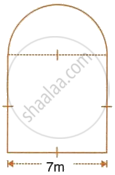Advertisements
Advertisements
Question
If a sphere is inscribed in a cube, find the ratio of the volume of cube to the volume of the sphere.
Solution
In the given problem, we are given a sphere inscribed in a cube. So, here we need to find the ratio between the volume of a cube and volume of sphere. This means that the diameter of the sphere will be equal to the side of the cube. Let us take the diameter as d.
Here,
Volume of a cube (V1) = s3
= d3
Volume of a sphere (V2) `=(4/3)pi (d/2)^3`
`=(4/3) pi (d^3/8)`
`=(pid^3)/6`
Now, the ratio of the volume of sphere to the volume of the cube = `V_1/V_2`
`V_1/V_2 = d^3/(((pi d^3)/6))`
`= 6/pi`
So, the ratio of the volume of cube to the volume of the sphere is `6 : pi` .
APPEARS IN
RELATED QUESTIONS
A hemispherical bowl made of brass has inner diameter 10.5 cm. Find the cost of tin-plating it on the inside at the rate of ₹ 16 per 100 cm2.
`["Assume "pi=22/7]`
A hemispherical bowl is made of steel, 0.25 cm thick. The inner radius of the bowl is 5 cm. Find the outer curved surface area of the bowl.
`["Assume "pi = 22/7]`
A cylinder of same height and radius is placed on the top of a hemisphere. Find the curved
surface area of the shape if the length of the shape be 7 cm.
The cross-section of a tunnel is a square of side 7 m surmounted by a semi-circle as shown in the adjoining figure. The tunnel is 80 m long.
Calculate:
- its volume,
- the surface area of the tunnel (excluding the floor) and
- its floor area.

Find the surface area of a sphere, if its volume is 38808 cubic cm. `(π = 22/7)`
Find the volume of a sphere, if its surface area is 154 sq.cm.
Find the radius of the sphere whose surface area is equal to its volume .
The internal and external diameters of a hollow hemi-spherical vessel are 21 cm and 28 cm respectively. Find volume of material of the vessel.
A certain number of metallic cones, each of radius 2 cm and height 3 cm are melted and recast into a solid sphere of radius 6 cm. Find the number of cones used.
A manufacturing company prepares spherical ball bearings, each of radius 7 mm and mass 4 gm. These ball bearings are packed into boxes. Each box can have maximum of 2156 cm3 of ball bearings. Find the:
- maximum number of ball bearings that each box can have.
- mass of each box of ball bearings in kg.
(use π = `22/7`)
